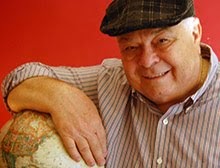 |
| Good things come in small packages such as Casa Wirth in Salto, Uruguay (casa wirth) |
SALTO,
URUGUAY – Savvy travelers know only too well
that their most treasured experiences are those unexpected gems that have been
overlooked by guidebooks and camera-laden tourists.
And sometimes the
best places to visit are the ones that require a little effort to get there.
Whether it is the satisfaction of accomplishing something that tests your
wanderlust spirit or nothing more than the personal pride of discovery, there
is something magical about finding a traveler’s treasure hidden among a world
of tourism.
 |
| Peter Wirth was raised in the hospitality industry (casa wirth) |
Peter Wirth is an
enterprising hotel entrepreneur with a rich pedigree in the business. After
growing up in the surroundings of the luxurious Hotel Hassler in Rome, he
became Executive Director of Waldorf Towers in New York.
The Bucher-Wirth
family is a familiar name to veteran travelers that is filled with tradition
and heritage. For five generations they have been catering to the world’s most
prestigious clientele and their name is revered throughout Switzerland and
Italy where the family perfected the art of hospitality.
Following the family
legacy, Peter ventured into Mexico where he established the first Relais &
Chateaux property there in San Miguel Allende.
 |
| Simple elegance is the theme at Casa Wirth (casa wirth) |
Now Peter has returned
to Latin America with his most recent “Inn-carnation” known as Casa Wirth in Salto, Uruguay. In the true spirit of
the family tradition, Casa Wirth labels itself “Your Uruguayan home with a heart” where the only requirement
is to “enjoy simple life with a touch of class.”
 |
| Garden bedroom (casa wirth) |
To be sure, Casa
Wirth is off-the-beaten-path. Having lived in New York, Peter Wirth knows all
to well that there is Broadway, Off-Broadway and Off-Off-Broadway. In the world
of travel, Casa Wirth is termed a “pathfinder” destination, which is code for “off-off-the-beaten-path.”
But that’s part of the magic, and it does not mean that you must sacrifice
comfort or luxury.
To begin with, the 12,000 square foot estate was once the
love nest of an Argentinian ballerina that has been renovated into a secluded
five guest room hideaway nestled along the shores of the Rio Uruguay.
 |
| Traditional barbecue at Casa Wirth where you can experience Gaucho life (casa wirth) |
Each room is uniquely furnished with colonial flair that
retains the original style. It is tasteful and “unfussy” rather than plush.
Bathrooms have been designed to offer individuality and peerless character.
And, just so the “civilized” world doesn’t get too far away, free Wi-Fi is also
included.
Half of the property is a garden where guests can enjoy a
traditional asado or Uruguayan barbecue.
Casa Wirth is a place that time forgot where you can pick a
fresh passion fruit from a tree and savor its succulent juiciness as you settle
back among the aroma of fragrant orchids and roses.
Breakfast is included and lovingly prepared by the staff who
will also wash and iron your clothes, if you like.
A short 30-minute drive from Salto, Uruguay’s second largest
city, guests at Casa Wirth are welcomed at Estancia Don Pipo, a 2,470 acre
ranch with over 100 Criollo and Arab horses as well as a herd of 400 cattle.
This is the world of the gauchos, and it’s the real thing.
 |
| Criollo horse (wikipedia) |
Visitors can spend the day or experience the estancia
overnight in one of its cottages. Estancia Don Pipo’s owner is also Swiss,
which ensures the ultimate in hospitality and charm.
Other activities at Estancia Don Pipo include horseback
riding, bird watching and an opportunity to experience the world of the
gauchos.
As cruise ships like to say, “At Casa Wirth, you can do
everything or you can do nothing at all.” For the “do everything” crowd, there
are wine tours, access to the Club Romero gym, paragliding, tours of colonial
landmarks, visits to the pilgrimage site of Padre Pio and the San Antonio
battlefield and the relaxing thermal pools of Termas de San Nicanor.
 |
| Angus herd at Estancia Don Pipo (casa wirth) |
It is also possible to take a ferry to Argentina
Best of all are the prices. At $85 per night for a double
room including breakfast and fresh local orange juice, you might just stay
forever.
 |
| Chinese chair (casa wirth) |
The entire casa can also be reserved, complete with a private
kitchen and full staff including gardener, handyman and housekeeper/cook. Casa
Wirth can accommodate up to 10 guests, but there is no minimum required to
reserve the entire property for $390 per night.
As mentioned above, getting there requires a flight to either
Montevideo or Buenos Aires
Anyone familiar with the Bucher-Wirth reputation for
excellence knows all too well that they are “out-of-the-box” experts in the art
of comfort and privacy.
 |
| Casa Wirth is furnished with traditional Colonial antiques from Uruguay (casa wirth) |
Peter Wirth continues that
tradition with his newest enterprise, Casa Wirth in Salto , Uruguay Uruguay
As Peter Wirth puts it, “Mi Casa es Tu Casa
at Casa Wirth!” W





























